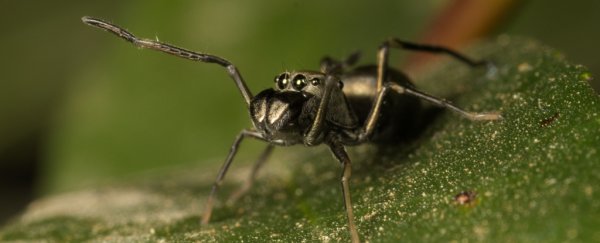Jumping spiders are already among the most adorable members of the arachnid order, but we're ready to give them the prize, officially. A species of ant-mimicking jumping spider has just been found suckling its babies on milk. You know what else does that? Kitties. Doggos. Mousies.
But Toxeus magnus is much more diligent than mouse mamas. She will continue to nurse her babies until long after they can forage for themselves - and for twice as long as rats and mice.
This is a high standard of infant care that had been thought exclusive to mammals.
"But ScienceAlert!" you are saying. "Spiders don't have nipples!" (You may also be making some rude remarks about whether spiders can ever be cute. There are some people on our team who agree with you on that.)
While it's true that spiders do not have nipples, it turns out that T. magnus doesn't actually need them.
The discovery was made by behavioural ecologist Chen Zhanqi of the Chinese Academy of Sciences and his team, who noticed some odd behaviours practised by the spiders.
Firstly, although these spiders are not known to form colonies, nests in the wild are often found containing a number of members, including grown juveniles. This caught Chen's attention, and he brought some of the spiders into his lab for closer study.
Once they were safely ensconced in an artificial nest, he noticed the second odd thing: for 20 days, the wee spiderlings did not leave the nest at all, and yet mum was not bringing them any food.
And then, when the the babies did emerge, the third odd thing: a juvenile attached to a mother, like a young mammal at its mother's teat - and the mother seemed to be tending to the baby in a caring way.
So Chen and his colleagues started to really take a closer look - and discovered that the mother was in fact producing a kind of milk for her babies. The stuff was nutrient-rich, containing nearly four times the protein found in cow's milk, as well as sugar and fat.
Here's how it goes. The mother spider lays a clutch of eggs, typically between 2 and 36. When the babies hatch, the mother deposits tiny droplets from her epigastric furrow, the opening on her abdomen from which she lays her eggs.
The newly hatched babies sip from these droplets from the first few days of their life; but as they gain a little bit of size and strength, they are able to suckle directly from the mother's epigastric furrow.
This is how they feed, exclusively, for about 20 days. This is also typically the length of time mice and rats suckle before they are weaned.
But, although at about the 20 day mark, the spiderlings are able to leave the nest and start finding their own food, they continue to supplement their foraging with mother's milk for another 20 days - a total of 40 days nursing.
In the lab, this resulted in a survival rate of around 76 percent. And it does look like the extended nursing time is crucial.
When Chen and his colleagues cut off the mother's milk supply, spiderlings younger than 20 days died, while those older than 20 days were fine. Meanwhile, when the mother was removed entirely, older spiderlings tended to leave the nest sooner, didn't grow as quickly, and were less likely to survive to adulthood.
The scientists aren't sure exactly what the milk is made of, but suggest it could be liquefied, unfertilised eggs. Some other animals feed their young with unfertilised eggs - frogs, for instance, and bees, although generally the eggs are laid as per normal, and the young just eat them.
T. magnus' milk could be a similar source of nutrition, although supplied via a different delivery method. In fact, the duration of care she provides her babies is rare even in mammals, only seen in a few long-lived social species such as humans and elephants.
"The extended maternal care indicates that invertebrates have also evolved [this] ability," Quan Rui-Chang of the Chinese Academy of Sciences told Science magazine.
The team's research has been published in the journal Science.
